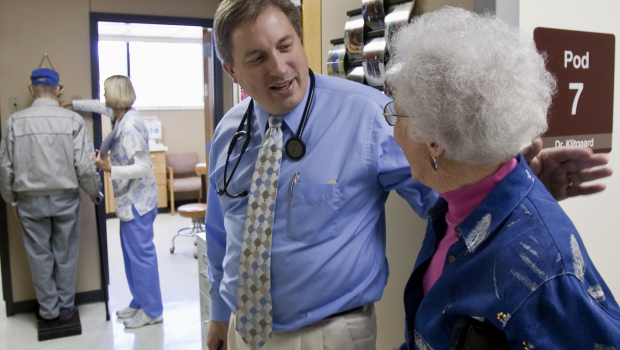AARP Hearing Center
The Takeaway: Docs Face Steep Medicare Pay Cut (Again); New Book Explores 'Ageless Homes'
By Elizabeth Nolan Brown, November 28, 2011 09:12 AM

I don't see how primary care doctors could take anywhere near like a 27-percent pay cut and continue to function," Dr. Don Klitgaard, a family physician, said. "I assume there's going to be a temporary fix, because the health care system is going to implode without it."
A permanent fix to the problem would cost about $300 billion over 10 years, making it almost impossible to push through in these budget-cut-conscious times. Instead, Congress must scramble every one or two years to pass a temporary fix with the clock ticking-which hardly seems efficient, does it? It's 'almost comical' lawmakers would let the situation get so far out of hand, said Klitgaard. But Medicare patients are unlikely to be laughing, as more doctors, increasingly irritated about dealing with Medicare, consider shunning new Medicare patients.
The solution-which continues to elude policymakers-is an overhaul of Medicare's payment system so doctors are rewarded for providing quality, cost-effective care, said Mark McClellan, an economist and medical doctor who served as Medicare administrator for President George W. Bush. Instead, the threat of payment cuts has become a holiday tradition, said McClellan. "It's just not a very enjoyable one."
Unassisted Living: A new book from architect Wid Chapman and gerontologist Jeffrey P. Rosenfeld explores (in full-pictured glory) 33 examples of homes that have been designed with an eye toward aging in place. Unassisted Living: Ageless Homes for Later Life includes projects ranging from a remote single-family mountain house to a multigenerational community. The New York Times interviewed Chapman and Rosenfeld about how aging boomers' housing wants differ from previous generations and what makes a house suitable for aging.
Mr. Rosenfeld: As we began the project and talked to friends, who are mostly boomers, they said again and again: "There's no way I'm moving into a nursing home. You're going to have to shoot me first." Mr. Chapman: Gone is the idea of heading south at a particular age. The whole notion of retirement is changing. There is no set retirement age. Technology is allowing us to combine leisure and work in a remote setting, so there are a lot of changes that are facilitating a completely different mind-set. Mr. Rosenfeld: Years ago, Jane Jacobs was asked where should older people live. She said everywhere. We'd like to think boomers are leading that charge
See Also: Remodeling Ideas Now to Live Independently Later >>
The pair note that houses designed with aging in mind will have a lack of thresholds as you enter, accessible bathrooms and showers, décor that makes for easy navigation, slip-proof surfaces and a lack of clutter.
Monday Quick Hits:
- The dilemma of caring for aging parents-from an aging parent's perspective. Eighty-seven year old author Lillian Rubin writes: "Most of the children I spoke with in the research for my book, 60 On Up: The Truth About Aging in America, actively worry about their aging parents, often well before their parents need any help."
- Actress Ellen Barkin, 57, talks Twitter (she loves it), her ex-husbands (mixed feelings) and why she's not afraid to discuss her age.
- Four common medications-two for diabetes and two blood-thinning agents-account for two-thirds of older adults' drug-related emergency hospitalizations, a new study finds.
- And geriatric physician Gene Dorio says more doctors and families members need to have honest discussions about end-of-life issues with those in failing health.
Photo: AP































































